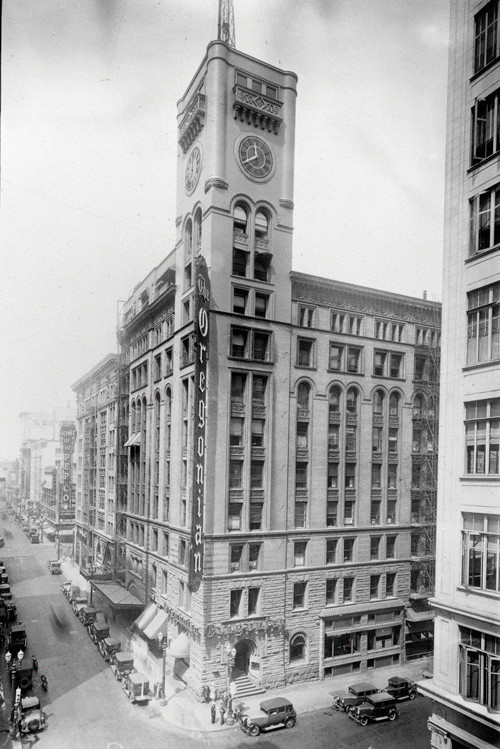The Story of O

Built in 1892, the old Oregonian building at SW Sixth and Alder was demolished in 1950.
Let us count the signs pointing to the Oregonian’s demise as a daily printed newspaper—and weigh them against its history of survival.
The paper’s circulation on weekdays, which has been shrinking for years, dropped another 6 percent in 2012, to 228,599. The newsroom has seen prize-winning reporters flee to PR, government jobs, and even a longtime nemesis, Willamette Week. Famed political cartoonist Jack Ohman recently jumped ship for the Sacramento Bee, of all places. Last year, the Oregonian’s parent company announced that several of its papers, including the Cleveland Plain Dealer and New Orleans’s Times-Picayune, would print just three times a week.
Oregonian publisher N. Christian Anderson III has denied an imminent similar move. But many believe it’s just a matter of time. “It has become seemingly impossible to make money creating daily compendiums and throwing it on people’s doorsteps,” wrote David Carr of the New York Times last year.
But whatever changes come, obituaries would be premature. Portland’s paper has had its back against the wall before. Somehow, it always found an escape route.
The Oregonian launched in 1850 as a newspaper catering to the Whig Party, a GOP precursor. By 1860, the paper had become known for brass-knuckled pro-Republican commentary, part of a ferocious brand of partisan journalism known nationally as “the Oregon Style.” In 1880, the O opined of the Democratic Party: “[T]hey have fabricated more and more audacious fictions ... calculated to disgust and alienate even intelligent democrats, and to reduce the party to the sodden and stupid elements.”
The strategy worked, at first. By 1892, the O’s owner, Henry Pittock, had erected one of the city’s first skyscrapers at SW Sixth Avenue and Alder Street. Yet by the Great Depression, circulation of the “Old Lady of Alder Street” had plummeted. In 1934, the board hired a Great War vet named Guy T. Viskniskki to turn things around.
“The Oregonian finds itself on evil days,” Viskniskki wrote. “It must quit being a Model T newspaper in a V-8 age.” Viskniskki made headlines bigger, added pictures, dialed down the rhetoric, and packed in more local news. Some dismissed his approach as “sensationalist” and “yellow,” but the shake-up was a success. By 1939, the Oregonian’s circulation had reached a then-record 120,000.
After World War II, the paper became the state’s dominant printer of mainstream news and views, but it did change course several times. In the mid-1970s, it tacked to capture an increasingly suburban, nonwhite, nonmale readership. “A newspaper is a living thing,” observed O editor J. Richard Nokes. “It must be relevant to all age groups and segments of the population....” Solutions included a handyman column and an entertainment section edited by a New Yorker. (“Anybody from New York has to be an entertainment expert,” declared Nokes.)
But what now, when the predawn thwack of a folded broadsheet hitting the stoop every single morning has become a throwback with dubious business prospects? (“Some days of the week are just more profitable than others,” says Rick Edmonds of the journalism think tank Poynter Institute.) Across the publishing landscape, the general-interest approach is dying, but niches are on fire.
Here’s an idea: perhaps the O could consult the spicier parts of its own archives.
In July 1901, for example, the paper blasted socialists. “It is fortunate for the country that the revolutionists and desperadoes who attack social order and the law ... have become mighty unpopular.... [I]n their harangues they draw a smaller audience.” A local socialist showed up at the offices in a rage. Though managing editor Edgar Piper was able to talk this particular reader down, the episode convinced him to install an emergency buzzer at his desk that could summon the whole newsroom to his aid. A few days before, Piper had punched a visitor who was wielding a chair. Love the politics or abhor them, that was passion.
“Public taste ... waits for no one, and is relentless and cruel to the laggard.”
—Oregonian Editor Guy Viskniskki, 1934
Last year, Anderson hired editorial page editor Erik Lukens of the Bend Bulletin, whose previous work included a call for drilling in the Arctic National Wildlife Refuge—published on Earth Day. Leftie blogs cried havoc, but any rightward drift is subtle so far. Maybe too subtle. The paper declined to endorse a presidential candidate for the first time since 1964, and reported the election with a grudging headline: “Obama Keeps Job.” (Is passive-aggressiveness the new “Oregon Style”?) Lukens’s editorial page has made odd contrarian jabs—advocating reviving smoking in bars, for instance—but few waves.
Maybe the O should just go for it. A gadfly libertarian voice could be a combustible element in one of America’s liberal bastions. If the paper can once again rouse strong feelings, perhaps it will survive the 21st century just as it mutated through the 19th and 20th. It has less and less to lose.





